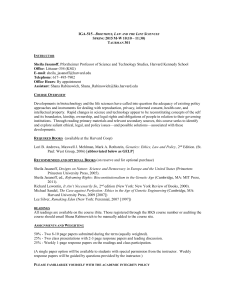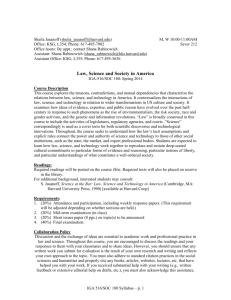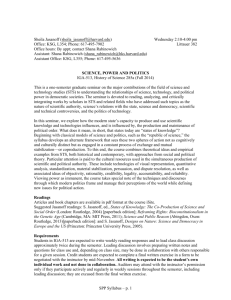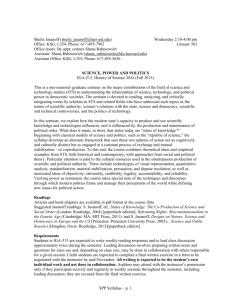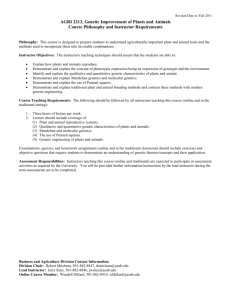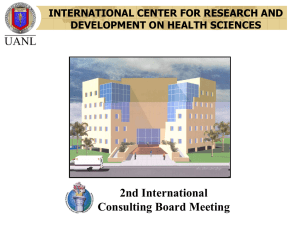NEW SYLLABUS - Harvard Kennedy School
advertisement
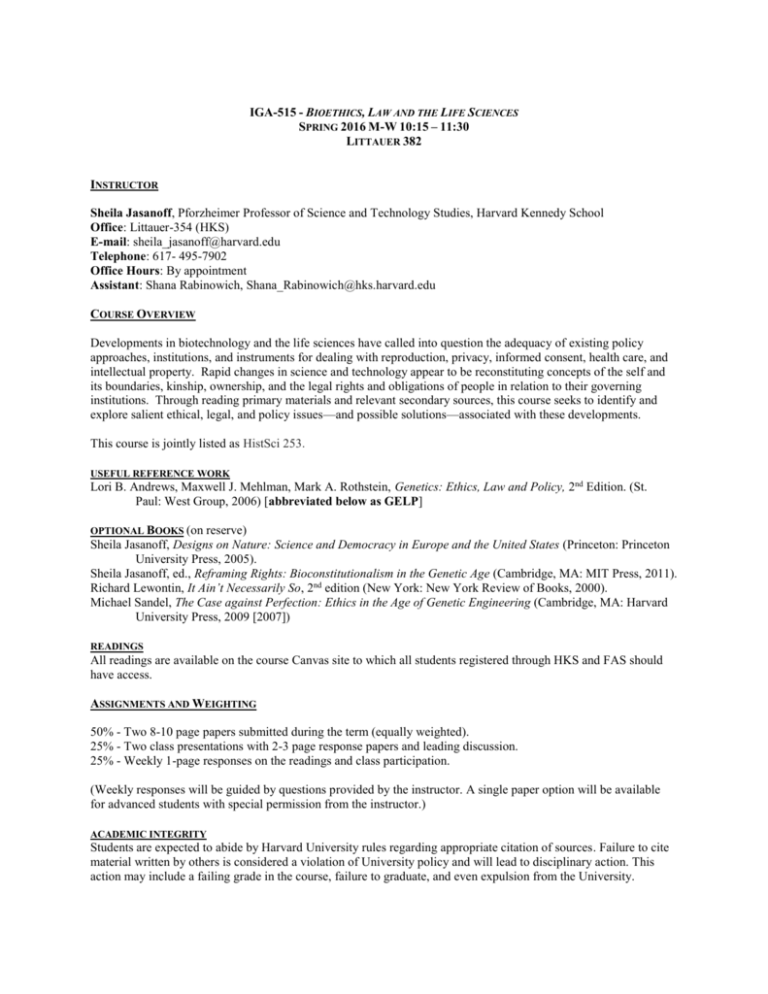
IGA-515 - BIOETHICS, LAW AND THE LIFE SCIENCES SPRING 2016 M-W 10:15 – 11:30 LITTAUER 382 INSTRUCTOR Sheila Jasanoff, Pforzheimer Professor of Science and Technology Studies, Harvard Kennedy School Office: Littauer-354 (HKS) E-mail: sheila_jasanoff@harvard.edu Telephone: 617- 495-7902 Office Hours: By appointment Assistant: Shana Rabinowich, Shana_Rabinowich@hks.harvard.edu COURSE OVERVIEW Developments in biotechnology and the life sciences have called into question the adequacy of existing policy approaches, institutions, and instruments for dealing with reproduction, privacy, informed consent, health care, and intellectual property. Rapid changes in science and technology appear to be reconstituting concepts of the self and its boundaries, kinship, ownership, and the legal rights and obligations of people in relation to their governing institutions. Through reading primary materials and relevant secondary sources, this course seeks to identify and explore salient ethical, legal, and policy issues—and possible solutions—associated with these developments. This course is jointly listed as HistSci 253. USEFUL REFERENCE WORK Lori B. Andrews, Maxwell J. Mehlman, Mark A. Rothstein, Genetics: Ethics, Law and Policy, 2nd Edition. (St. Paul: West Group, 2006) [abbreviated below as GELP] OPTIONAL BOOKS (on reserve) Sheila Jasanoff, Designs on Nature: Science and Democracy in Europe and the United States (Princeton: Princeton University Press, 2005). Sheila Jasanoff, ed., Reframing Rights: Bioconstitutionalism in the Genetic Age (Cambridge, MA: MIT Press, 2011). Richard Lewontin, It Ain’t Necessarily So, 2nd edition (New York: New York Review of Books, 2000). Michael Sandel, The Case against Perfection: Ethics in the Age of Genetic Engineering (Cambridge, MA: Harvard University Press, 2009 [2007]) READINGS All readings are available on the course Canvas site to which all students registered through HKS and FAS should have access. ASSIGNMENTS AND WEIGHTING 50% - Two 8-10 page papers submitted during the term (equally weighted). 25% - Two class presentations with 2-3 page response papers and leading discussion. 25% - Weekly 1-page responses on the readings and class participation. (Weekly responses will be guided by questions provided by the instructor. A single paper option will be available for advanced students with special permission from the instructor.) ACADEMIC INTEGRITY Students are expected to abide by Harvard University rules regarding appropriate citation of sources. Failure to cite material written by others is considered a violation of University policy and will lead to disciplinary action. This action may include a failing grade in the course, failure to graduate, and even expulsion from the University. 2 COURSE SYLLABUS 0. OVERVIEW 0. January 25 Overview of Course E. Lander, “Scientific Commentary: The Scientific Foundations and Medical and Social Prospects of the Human Genome Project,” Journal of Law, Medicine and Ethics 26: 84-88 (1998), http://onlinelibrary.wiley.com.ezp-prod1.hul.harvard.edu/doi/10.1111/j.1748-720X.1998.tb01418.x/pdf. B. J. Strasser, “Who Cares About the Double Helix,” Nature 422: 803-804 (24 April 2003). I. FOUNDATIONS 1. January 27: Promises F. S. Collins, et al., “A vision for the future of genomics research,” Nature 422:835-847. (24 April 2003) http://www.nature.com/nature/journal/v422/n6934/pdf/nature01626.pdf H. Varmus, et al., “Grand Challenges in Global Health,” Science 302:398-9 (2003). http://www.sciencemag.org/content/302/5644/398.full E. W. Clayton, “Ethical, Legal, and Social Implications of Genomic Medicine,” New England Journal of Medicine 349:562-9 (2003). 2. February 1: Limits F. Fukuyama, Our Posthuman Future, Ch. 5, “Genetic Engineering,” 72-83. P. Rabinow, “Getting to Know You,” Nature Biotechnology 20:545-546 (June 2002). G. Annas, “Mapping the Human Genome and the Meaning of Monster Mythology,” Emory Law Journal 39(3);629664 (1990). E. Kac, “Natural History of the Enigma,” http://www.ekac.org/nat.hist.enig.html (browse). 3. February 3: Risks, Opportunities, and Utilitarian Ethics J. Craig Venter on Synthetic Biology at NASA Ames, January 12, 2011, http://www.youtube.com/watch?v=KTzG_HIUu9c (55 minutes; skim). R. Kwok, “Five Hard Truths for Synthetic Biology,” Nature, January 20, 2010, http://www.nature.com/news/2010/100120/full/463288a.html J. J. Thomson, “The Trolley Problem,” Yale Law Journal 94(6):1395-1415 (May, 1985), http://philosophyfaculty.ucsd.edu/faculty/rarneson/Courses/thomsonTROLLEY.pdf President’s Commission for the Study of Bioethical Issues, New Directions: The Ethics of Synthetic Biology and Emerging Technologies, December 2010, Executive Summary, 1-18, available at http://bioethics.gov/cms/synthetic-biology-report. 4. February 8: Bioethics and ELSI GELP, 83-84. P. Singer, “Moral Experts,” Analysis 32(4):115-117 (1972), https://www.princeton.edu/~smcgrath/singer.pdf J. Evans, “Between Technocracy and Democratic Legitimation: A Proposed Compromise Position for Common Morality Public Bioethics,” Journal of Medicine and Philosophy 31(3): 213-234 (2006). II. CONSTITUTING THE GENETIC HUMAN 5. February 10: Biopower M. Foucault, The History of Sexuality, Vol. 1 (New York: Vintage, 1990 [1976]), (“Biopower”), 135-145. N. Rose, The Politics of Life Itself (Princeton: Princeton University Press, 2007), Ch. 5, “Biological Citizens,” 130154. V. Rabeharisoa and M. Callon, “The involvement of patients in research activities supported by the French Muscular Dystrophy Association,” in S. Jasanoff, ed., States of Knowledge: The Co-Production of Science and Social Order (London: Routledge, 2004), 234-253. [Presidents’ Day: No Class, February 15] 6. February 17: Bioconstitutional Selves S. Jasanoff, “Introduction: Rewriting Life, Reframing Rights,” in Jasanoff, ed., Reframing Rights, 1-9. 3 GELP, “Eugenics”, 51-56 (Buck v. Bell); 71-76 (Skinner v. Oklahoma). A. Wellerstein, “States of Eugenics: Institutions and Practices of Compulsory Sterilization in California,” in Jasanoff, ed., Reframing Rights, 29-58. Look at image archive on the American Eugenics Movement, posted by the Cold Spring Harbor Laboratory, available at http://www.eugenicsarchive.org/eugenics/ 7. February 22: Genetic Determinism R. Lewontin, Ch. 2, “All in the Genes?” in Biology as Ideology: The Doctrine of DNA (New York: Perennial, 1991), 17-38. G.E. Allen, “Modern Biological Determinism: The Violence Initiative,” in M. Fortun and E. Mendelsohn, eds., The Practices of Human Genetics (Dordrecht: Kluwer, 1999), 1-23. C. Dean, “James Watson Retires After Racial Remarks,” New York Times, October 25, 2007, http://www.nytimes.com/2007/10/25/science/25cnd-watson.html B. Borrell, “Watson's Nobel medal sells for US$4.1 million,” Nature, December 4, 2014, http://www.nature.com/news/watson-s-nobel-medal-sells-for-us-4-1-million-1.16500 N. Wade, “Genes Play Major Role in Primate Social Behavior, Study Finds,” New York Times, December 19, 2011, http://www.nytimes.com/2011/12/20/science/genes-play-major-role-in-primate-social-behavior-studyfinds.html?scp=1&sq=genes%20behavior&st=cse 8. February 24: Genes and Sexuality I. Hacking, Ch. 5, “Kind-making: The Case of Child Abuse,” in The Social Construction of What? (Cambridge, MA: Harvard University Press, 1999), 125-162. Bowers v. Hardwick, 478 U.S. 186 (1986), [edited version], http://caselaw.lp.findlaw.com/scripts/getcase.pl?court=US&vol=478&invol=186 Lawrence v. Texas, 539 U.S. 558 (2003) [edited version], http://web.utk.edu/~scheb/decisions/Lawrence.htm 9. February 29: Genetics and the Family: Assisted Reproduction In re Marriage of John A. and Luanne H. Buzzanca, 72 Cal. Rptr.2d 280 (Cal. Ct. App. 1998) [especially Discussion], http://law.justia.com/cases/california/court-of-appeal/4th/61/1410.html C. Thompson, Making Parents: The Ontological Choreography of Reproductive Technologies (Cambridge, MA: MIT Press, 2005), Ch. 4, “Is Man to Father as Woman Is to Mother?” 117-143. S. Jasanoff, Designs on Nature: Science and Democracy in Europe and the United States (Princeton: Princeton University Press, 2005), Ch. 6, “Natural Mothers and Other Kinds,” 146-170. J. Mroz, “One Sperm Donor, 150 Offspring,” New York Times, September 5, 2011, http://www.nytimes.com/2011/09/06/health/06donor.html?scp=1&sq=sperm%20donor&st=cse 10. March 2: Genetic Enhancement: Clones and Designer Babies A. Buchanan et al., From Chance to Choice: Genetics and Justice (Cambridge: Cambridge University Press, 2000), Ch. 5, “Why Not the Best?,” 156-203. M. J. Sandel, “The Case against Perfection,” Atlantic, April 2004: 51-62, http://www.theatlantic.com/doc/200404/sandel A. Knapp, “Is Ethical Human Genetic Enhancement Possible?” Forbes, September 15, 2011, http://www.forbes.com/sites/alexknapp/2011/09/15/is-ethical-human-genetic-enhancement-possible/2/ 11. March 7: Genes and Human Diversity J. E. Reardon, “Democratic Mis-haps: The Problem of Democratization in a Time of Biopolitics,” BioSocieties 2:239-256 (June 2007). J. Couzin, “New Mapping Project Splits Community,” Science 296:1391-1392 (2002). A. Harmon, “Indian Tribe Wins Fight to Limit Research of Its DNA,” New York Times, April 21, 2010, http://www.nytimes.com/2010/04/22/us/22dna.html?scp=2&sq=arizona%20state%20havasupai&st=cse HapMap Project Web Sites: International HapMap Homepage, http://www.hapmap.org/ NIH HapMap page, http://www.genome.gov/page.cfm?pageID=10001688 III. RIGHTS AND INTRUSIONS 12. March 9: Rights to Life: Abortion, Embryos, Stem Cells 4 S. Jasanoff, “Making the Facts of Life,” in Jasanoff, ed., Reframing Rights, 59-83. Roe v. Wade, http://www.foxnews.com/projects/pdf/roevwade.pdf Planned Parenthood v. Casey, http://www.law.cornell.edu/supct/html/91-744.ZO.html Quintavalle v. Human Fertilisation and Embryology Authority [2002] EWCA Civ 667 (UK), www.hfea.gov.uk/docs/ELC_CA_Judgement_June04.pdf HFEA Policy Statement on Eggs for Research, February 2007, http://www.hfea.gov.uk/471.html [Spring Break: March 14 and 16] 13. March 21: Testing, Screening, Stigmatizing D. Beeson, T. Duster, “African-American Perspectives on Genetic Testing,” Ch. 7, in J. S. Alper, et al, The DoubleEdged Helix: Social Implications of Genetics in A Diverse Society (Baltimore: Johns Hopkins University Press, 2002), 151-174. S. Parthasarathy, “Regulating Risk: Defining Genetic Privacy in the US and Britain,” Science, Technology, and Human Values 9(3):332-352 (2004). J. Couzin-Frankel, “Peering into My Genome,” Science (4 December 2014), http://news.sciencemag.org/biology/2014/12/feature-peering-my-genome 14. March 23: Genetic Surveillance and Criminal Law B. Steinhardt, “Privacy and Forensic DNA Data Banks,” in Lazer, ed., DNA and the Criminal Justice System, 173196. S. Jasanoff, “DNA’s Identity Crisis,” in D. Lazer, ed., DNA and the Criminal Justice System (Cambridge: MIT Press, 2004), 337-355. J. D. Aronson, “Certainty vs. Finality: Constitutional Rights to Postconviction DNA Testing,” in Jasanoff, ed., Reframing Rights, 125-146. Browse The Innocence Project website, http://www.innocenceproject.org/. Optional: District Attorney v. Osborne, 557 U.S. 52 (2009) [available as pdf]. **** [1st paper due in class: 8-10 pages] **** 15. March 28: Our Genes, Our Selves? Moore v. Regents of the University of California, http://www.kentlaw.edu/perritt/courses/property/moore-v-regentsexcerpts2.htm H. Landecker, “Between Beneficence and Chattel: The Human Biological in Law and Science,” Science in Context 12:203-225 (1999). R. Skloot, “Taking the Least of You,” New York Times Magazine, April 16, 2006, http://www.nytimes.com/2006/04/16/magazine/16tissue.html D. Grady, “A Lasting Gift to Medicine That Wasn’t Really a Gift,” New York Times, February 1, 2010, http://www.nytimes.com/2010/02/02/health/02seco.html IV. MONEY, MARKETS, PROPERTY 16. March 30: Visions of Progress S. Jasanoff, Designs on Nature, Ch. 9, “The New Social Contract,” 225-246. A. Stockdale and S. F. Terry, “Advocacy Groups and the New Genetics,” Ch. 4, in J. S. Alper, et al, The DoubleEdged Helix: Social Implications of Genetics in A Diverse Society (Baltimore: Johns Hopkins University Press, 2002), 80-101. National Bioethics Advisory Commission, Ethical and Policy Issues in Research Involving Human Participants, Appendix C, 151-16 https://bioethicsarchive.georgetown.edu/nbac/human/overvol1.pdf G. O. Schaefer, E. J. Emanuel, and A. Wertheimer, “The Obligation to Participate in Biomedical Research,” JAMA 302(1):67-72 (July 1, 2009), http://www.ncbi.nlm.nih.gov/pmc/articles/PMC2763192/ K. Saha and J. B. Hurlbut, “Research ethics: Treat donors as partners in biobank research,” Nature, October 20, 2011, http://www.nature.com/nature/journal/v478/n7369/full/478312a.html 5 17. April 4: Science and (Private) Money A. Rai and R. Eisenberg, “Bayh-Dole Reform and the Progress of Biomedicine,” Law and Contemporary Problems 66 (2003):289-314, http://scholarship.law.duke.edu/cgi/viewcontent.cgi?article=1282&context=lcp E. Press and J. Washburn, “The Kept University,” Atlantic Monthly (March 2000):39-54, W. Lepkowski, “Biotech’s OK Corral,” Science and Policy Perspectives 13 (9 July 2002), http://archive.cspo.org/_old_ourlibrary/documents/060902.html D. Caruso, “Someone (Other Than You) May Own Your Genes,” New York Times, January 28, 2007, http://www.nytimes.com/2007/01/28/business/yourmoney/28reframe.html?_r=1&scp=1&sq=hilgartner&or ef=slogin 18. April 6: Intellectual Property and Technology Transfer P. Rabinow, Making PCR: A Story of Biotechnology (Chicago: University of Chicago Press, 1996), 19-45. Washington University v. Catalona, 490 F. 3d 667 (8 Cir. 2007), http://scholar.google.com/scholar_case?case=7283524957057325487&hl=en&as_sdt=2&as_vis=1&oi=sch olarr J. Kaiser, “Court Decides Tissue Samples Belong to University, Not Patients,” Science 312(5772):346 (April 21, 2006), http://www.sciencemag.org/cgi/content/full/312/5772/346; see Court Order at http://www.whoownsyourbody.org/catalona.html M. Crichton, “Bodysnatchers 2006,” Wall Street Journal, December 2006, http://www.michaelcrichton.net/essaywsj-bodysnatchers.html 19. April 11: Patenting Life Diamond v. Chakrabarty, 447 U.S. 303 (1980), https://supreme.justia.com/cases/federal/us/447/303/ President and Fellows of Harvard College v. Canada (Commissioner of Patents), [2002] 4 S.C.R. 45, available at http://reports.fja.gc.ca/eng/2000/2000fc27094.html S. Jasanoff, Taking Life: Private Rights in Public Nature,” in K. Sunder Rajan, ed., Lively Capital: Biotechnologies, Ethics, and Governance in Global Markets (Durham: Duke University Press, 2012), 155-183. M. Crichton, “This Essay Breaks the Law,” New York Times, March 19, 2006, http://www.michaelcrichton.net/essay-nytimes-thisessaybreaksthelaw.html Association for Molecular Pathology et al. v. USPTO and Myriad Genetics, 569 U. S. ____ (2013), http://www.law.cornell.edu/supct/pdf/12-398.pdf Chris Hansen, “Dis-Owning Nature: The BRCA Gene Patents and the Supreme Court,” Harvard University, November 12, 2013, http://vimeo.com/80093607 [especially discussion of ACLU strategy] 20. April 13: Biobanks: Uses and Abuses GELP, 706-712, Mayfield. H. Rose, The commodification of bioinformation: the Icelandic Health Sector Database. London: Wellcome Trust (2001), available at http://www.wellcome.ac.uk/stellent/groups/corporatesite/@msh_grants/documents/web_document/WTD00 3281.pdf J. Kaiser, “Population Databases Boom, From Iceland to the US,” Science 298 (2002):1158-61. Harvard Law Review, “Comparative Law – Genetic Privacy – Icelandic Supreme Court Holds That Inclusion of an Individual’s Genetic Information in a National Database Infringes on the Privacy Interests of his Child – Guðmundsdóttir v. Iceland, No. 151/2003 (Nov. 27, 2003) (Ice.), http://www.jstor.org.ezpprod1.hul.harvard.edu/stable/pdfplus/4093398.pdf?acceptTC=true D. Winickoff, R. Winickoff, “The Charitable Trust Model for Genomic Biobanks,” New England Journal of Medicine 349 (18 Sept. 2003):1180-4, available at http://content.nejm.org/cgi/reprint/349/12/1180.pdf V. BIOTECH AND GLOBAL GOVERNANCE 21. April 18: Agricultural Biotechnology: Northern Controversies J. Lassen, et al., “Testing times – the reception of Roundup Ready Soya in Europe,” Ch. 10 in M.W. Bauer and G. Gaskell, eds., Biotechnology: The Making of a Global Controversy (Cambridge: Cambridge University Press, 2002), 279-312. S. Jasanoff, Designs on Nature, Ch. 4, “Unsettled Settlements,” 94-118 6 R. Doubleday and B. Wynne, “Despotism and Democracy in the United Kingdom: Experiments in Reframing Citizenship,” in Jasanoff, ed., Reframing Rights, 239-261. Monsanto Canada Inc. v. Schmeiser, [2004] 1 S.C.R 902, available at http://scc.lexum.org/en/2004/2004scc34/2004scc34.html 22. April 20: Biotechnology and the Politics of Development S. Jasanoff, “Biotechnology and Empire: The Global Power of Seeds and Science,” Osiris 21(1):273-292 (2006). D. L. Kleinman, Science and Technology in Society (Malden: Blackwell, 2005), Ch. 2, “Ceding Debate: Biotechnology and Agriculture,” 15-33. R. Paarlberg, Starved for Science: How Biotechnology Is Being Kept out of Africa (Cambridge, MA: Harvard University Press, 2008), Conclusion, “An Imperialism of Rich Tastes,” 179-196. I. Scoones and D. Glover, “Africa’s Biotechnology Battle,” Nature 460 (2009):797-798. 24. April 25: Pharmaceuticals and Global Markets Commission on Intellectual Property Rights (UK), Integrating Intellectual Property Rights and Development Policy (September 2002), http://ecipit.org.eg/arabic/pdf/Integrating_IPR_and_Development_Policy.pdf; see Ch. 6, “Patent Reform,” 111-136; Ch. 8, “International Architecture,” 155-170. K. Sunder Rajan, “Two Tales of Genomics: Capital, Epistemology, and Global Constitutions of the Biomedical Subject,” in Jasanoff, ed., Reframing Rights, 193-216. Patently Ambitious: The Global Ambitions of India’s Biggest Drug Firms, The Economist (6 September 2003):56. http://www.economist.com/node/2043905 G. Harris and K. Thomas, “Low-Cost Drugs in Poor Nations Get a Lift in Indian Court,” New York Times, April 1, 2013, http://www.nytimes.com/2013/04/02/business/global/top-court-in-india-rejects-novartis-drugpatent.html?pagewanted=all. 25. April 27: Genomic Populations and “Universal” Rights J. Reardon, “Human Population Genomics and the Dilemma of Difference,” in Jasanoff, ed. Reframing Rights, 217238. Council for Responsible Genetics, Project: Genetic Bill of Rights, http://www.councilforresponsiblegenetics.org/projects/CurrentProject.aspx?projectId=5 Indigenous Peoples Council on Biocolonialism, Indigenous Research Protection Act, at http://www.ipcb.org/publications/policy/files/irpa.html Universal Declaration on the Human Genome and Human Rights, 1997, http://portal.unesco.org/en/ev.phpURL_ID=13177&URL_DO=DO_TOPIC&URL_SECTION=201.html Council of Europe, Protection of the human genome, Recommendation 1512 (2001)[1], http://assembly.coe.int/Documents/AdoptedText/ta01/EREC1512.htm **** [2nd paper due in class: 8-10 pages] ****
